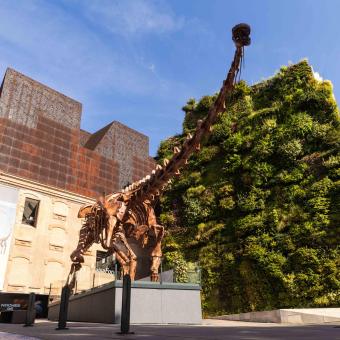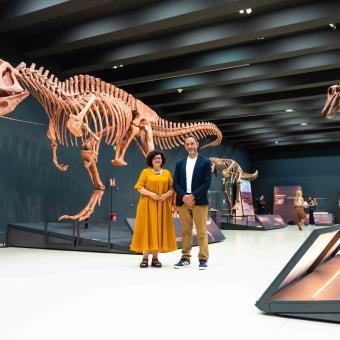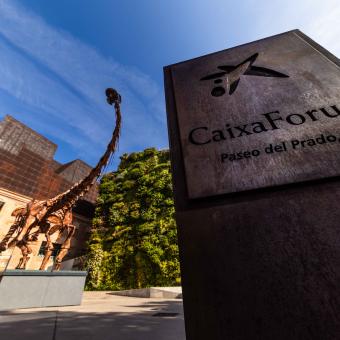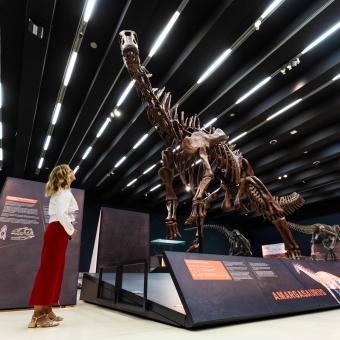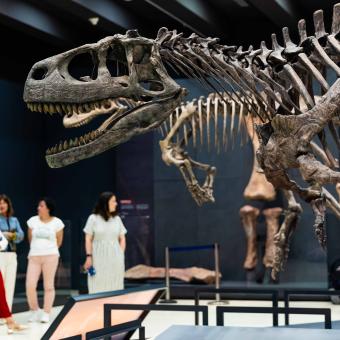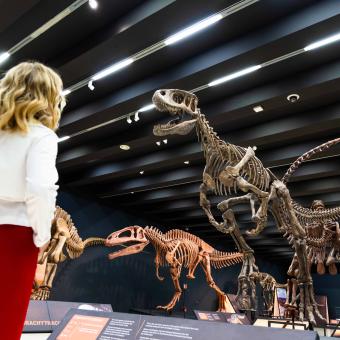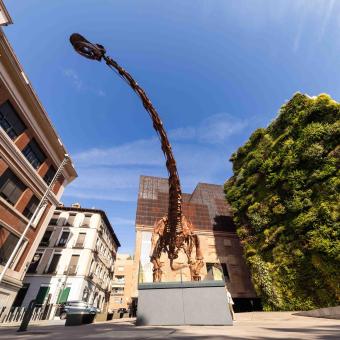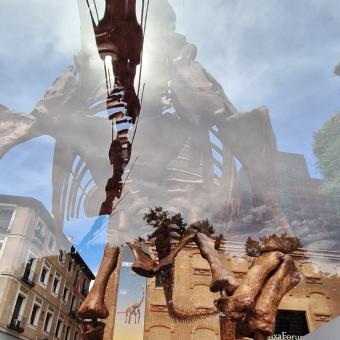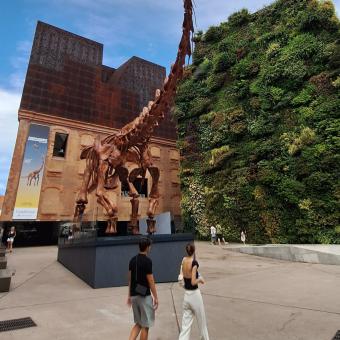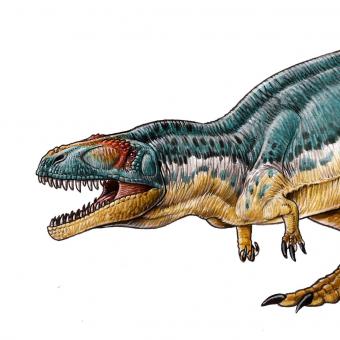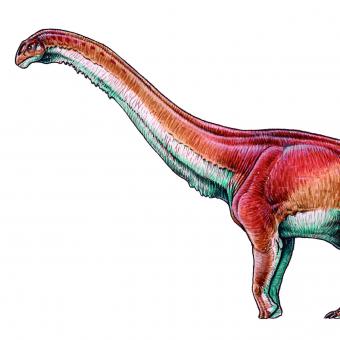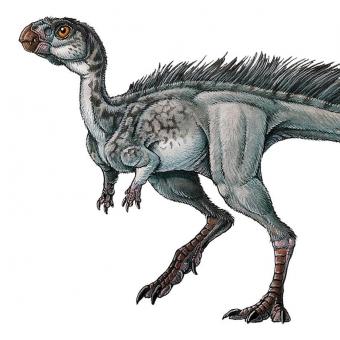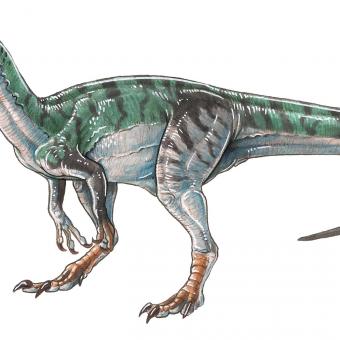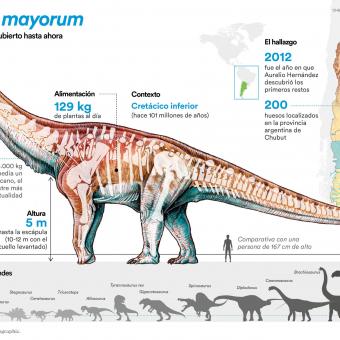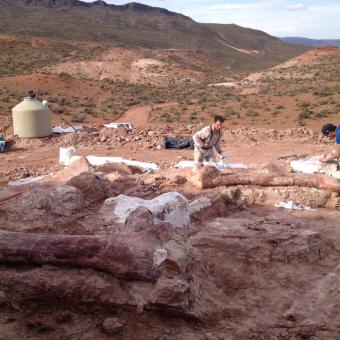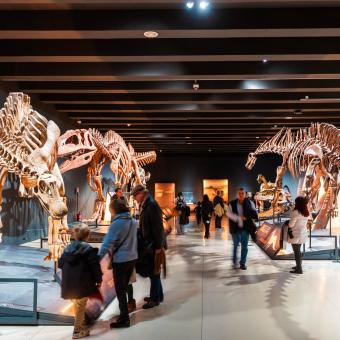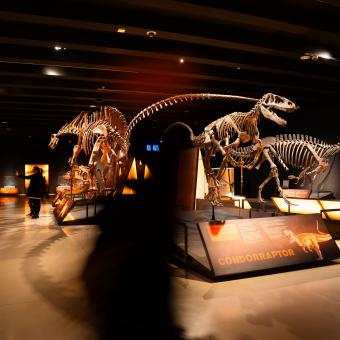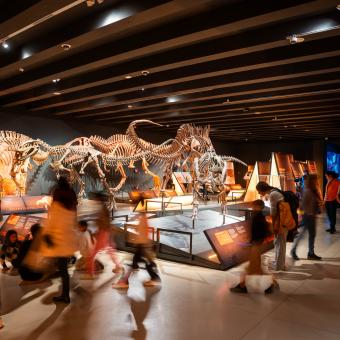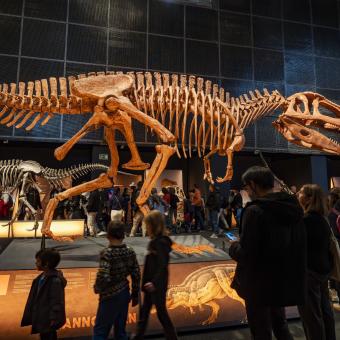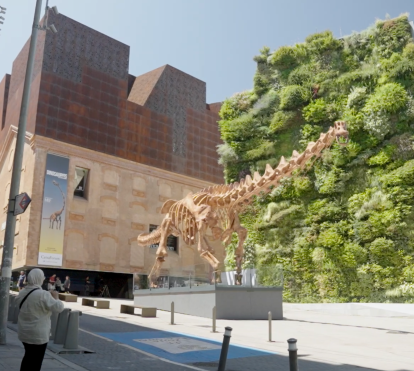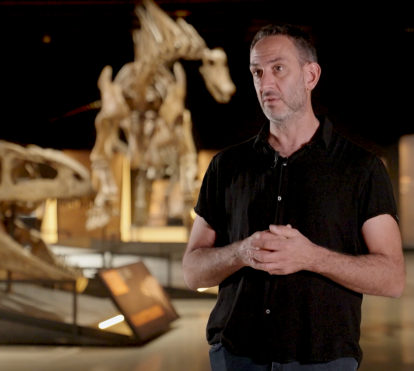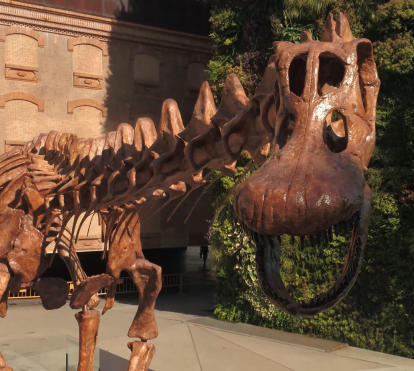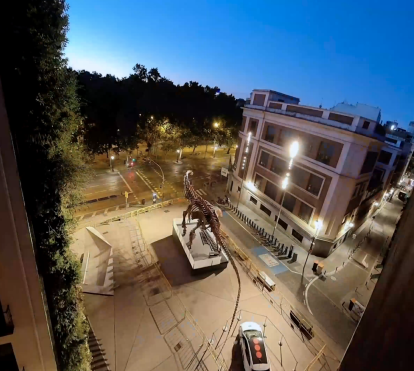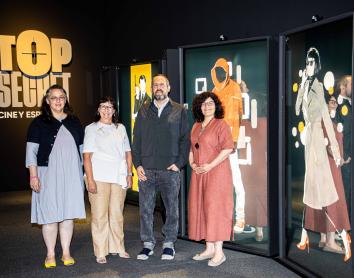
CaixaForum Madrid travels to the Patagonia of the Mesozoic Era in its new exhibition on dinosaurs
18.07.24
6 minutes readFrom today, CaixaForum Madrid will be hosting Dinosaurs of Patagonia, an exhibition developed by the Egidio Feruglio Palaeontological Museum (MEF) that reviews the evolution and enormous diversity of dinosaurs in one of the richest regions in terms of palaeontological remains of these fascinating animals. The star of the show, which contains 13 dinosaur specimens, is a life-size replica of the largest dinosaur ever known, the Patagotitan majorum.
The Director of CaixaForum Madrid, Isabel Fuentes, and the palaeontologist co-discoverer of the Patagotitan mayorum and researcher at the Egidio Feruglio Palaeontological Museum (MEF), José Luis Carballido, have presented Dinosaurs from Patagonia, a journey to the Patagonia of the Mesozoic Era to get an up-close look at the diverse dinosaurs that populated that land.
The exhibition created by the MEF opens to the public tomorrow at the CosmoCaixa Science Museum, where it can be seen until 6 April 2025. The display takes a look at the evolution of the different types of dinosaurs that inhabited Patagonia more than 200 million years ago and highlights their great diversity.
Visitors will be able to walk among life-size replicas of 13 species of dinosaurs that tell us about the evolution of carnivore and herbivore lineages, and allow us to learn about their characteristics, their differences and the times in which they lived.
One of the jewels of the exhibition is a striking replica of the largest known Patagonian dinosaur, the Patagotitan mayorum, one of the most important discoveries of this century in Patagonia. The remains of this titanosaur sauropod, which, as part of the exhibition, are on display for all to see in the public square of CaixaForum Madrid, were found 11 years ago in the province of Chubut (Argentina) and have provided deep insights into the gigantism of some dinosaur species. Patagotitan mayorum was 38 metres long and five metres high to the scapula, and its weight in life was estimated at 77 tonnes, the equivalent of 14 African elephants.
In addition to this giant, the exhibition shows more full-scale replicas, such as another of the largest dinosaurs (Tyrannotitan chubutensis); the smallest, measuring just 75 centimetres (Manidens condorensis), and two of the oldest, which lived 230 million years ago (Eoraptor lunensis and Herrerasaurus ischigualastensis).
The exhibition combines the impressive models with real fossils. Among the exhibits are two femurs, a humerus, an ulna and a radius of the Patagotitan. These are holotypes, the original specimens from which the description of this dinosaur species was determined. Visitors can also learn through audiovisuals about the environment in which the Patagotitan's remains were found and how they were excavated, which took three years and required another two years of laboratory work involving a team of more than 100 specialists from different disciplines.
Among the real fossils that can be seen up close are vertebrae of an ornithopod, teeth of sauropods such as Bagualia alba, or of theropods from the Carcharodontosauridae family, dinosaurs with constantly growing teeth, like sharks, as well as numerous fossils of local flora.
Dinosaurs from Patagonia
Dinosaurs lived on Earth during the Mesozoic Era, approximately 230 to 66 million years ago, so they never coexisted with humans at any point. These animals were characterised by having limbs held directly under the body, which allowed them to walk on two or four legs. Many dinosaurs also had additional bony structures, such as crests, horns or armour. Their diversification into numerous sizes, shapes and species resulted in a wide range of adaptations to different environments and lifestyles.
The exhibition allows visitors to discover, for example, that carnivorous theropod dinosaurs had a highly developed sense of smell, which could be one explanation for the common presence of a hole between the eye sockets. The public will also learn about the wide variety of neck lengths, from that of the Brachytrachelopan (the neck was 75% or less of the length of its dorsal spine) to that of the Patagotitan (where this proportion reached 400%). Another curiosity revealed by the exhibition is the existence of air sacs connected to the lungs, a system that originated with the dinosaurs, but is also found in present-day birds.
In the case of the dinosaurs of Patagonia, the diversity of characteristics is also remarkable, as we have learned from the numerous remains found in the sedimentary rocks of this region. At the beginning of the Mesozoic Era, the planet's continents were united in a single land mass (Pangaea), meaning that today's Patagonia was then attached to Africa and washed by the Pacific to the west. The passing of the centuries and the evolution of the planet transformed the wooded, swampy and jungle land where the dinosaurs lived into an arid place where, in recent decades, the best-preserved remains in the southern hemisphere have been found.
The exhibition presents specimens belonging to all three periods of the Mesozoic Era: Triassic, Jurassic and Cretaceous. Some of the most outstanding are:
TRIASSIC
Eoraptor lunensis
This is one of the most primitive specimens, which inhabited the Earth 230 million years ago, and therefore provides valuable information about the evolution of the first dinosaurs. Notable characteristics:
- It had claws on three toes.
- It was omnivorous.
- An adult specimen was approximately one metre long and 45 centimetres high, with a weight of 10 kilos.
Herrerasaurus ischigualastensis
This is another of the oldest known dinosaurs, occasionally considered a non-dinosaur due to its characteristics. However, the discovery of a complete skeleton with a skull helped to classify it correctly. Notable characteristics:
- It was a carnivore with large, sharp teeth, capable of digesting the bones of its victims.
- It preyed on large reptiles, such as Saurosuchus.
- Its peripheral vision was almost global.
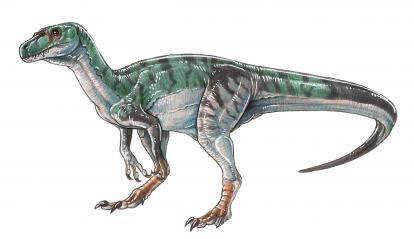
JURASSIC
Brachytrachelopan mesai
This is the only known species of its genus and neither its body structure nor its neck follow the typical pattern of the rest of the sauropods. Notable characteristics:
- It had a short neck, an evolutionary trait that helped it to save energy and consume other types of plants so as not to compete with the large sauropods.
- It formed large herds for travelling.
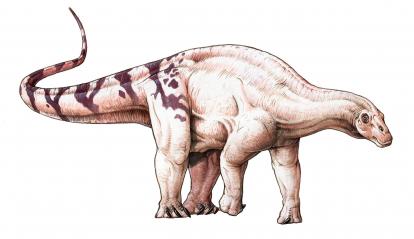
Manidens condorensis
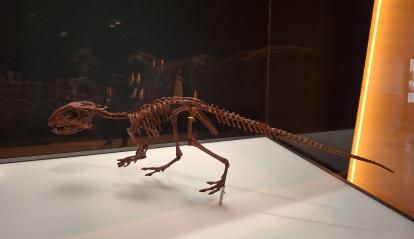
This is one of the smallest dinosaurs in the world and lived 85 million years ago. Notable characteristics:
- It could be bipedal with adaptations to arboreal life.
- It was about 75 centimetres long and weighed one kilo.
CRETACEOUS
Patagotitan mayorum

In 2012, farmer Aurelio Fernández discovered a first dinosaur bone on the farm where he worked, in the province of Chubut, which is part of Argentine Patagonia. Following years of work, a team from MEF led by José Luis Carballido and Diego Pol unearthed more than 200 fossils from seven specimens of what ended up being called Patagotitan mayorum (Patagonian titan of the Mayo family, after the surname of the owners of the farm where it was found)
The well-preserved state of the bones and the quantity of remains found – the Patagotitan has one of the richest fossil records of dinosaurs in South America – made it possible to obtain the anatomical reconstruction of this long-necked, quadrupedal creature, with a small head and long tail. The measurement of the circumference of its humerus and femur, as well as a three-dimensional reconstruction carried out by scanning all the bones, allowed its size to be estimated. Its 38-metre length make it the largest animal ever to have inhabited the Earth. Notable characteristics:
- This herbivore needed to eat 129 kg of plants per day.
- Unlike other sauropods, it did not have hollow bones, suggesting that it moved slowly to optimise energy and oxygen consumption.
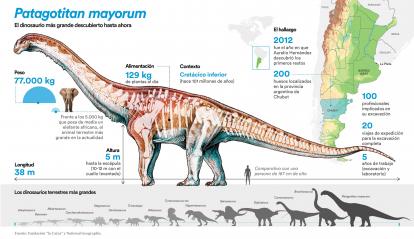
Tyrannotitan chubutensis
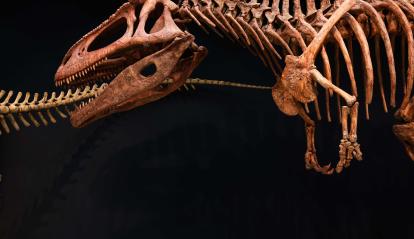
This dinosaur inhabited the Earth 120 million years ago and was a predator of Patagotitan mayorum, as confirmed by the discovery of 57 teeth of this species alongside the remains of the Patagotitan found in Chubut. Notable characteristics:
- It had very short arms, similar to those of Tyrannosaurus rex.
- It ran on its hind legs and reached speeds of 30 kilometres per hour.
- It was 12 metres long and weighed about six tonnes.
About the Egidio Feruglio Palaeontological Museum (MEF)
The Egidio Feruglio Palaeontological Museum (MEF) has become a reference point for palaeontological research in Argentina and is a key education and training centre in Latin America. Its scientific and research strengths include the following:
- - A permanent team of researchers, among them several of Latin America's leading and most distinguished palaeontologists, possibly part of the next generation of global experts in the field.
- - A strong and substantial track record of scientific publications in the most renowned international journals, such as Nature, Science and Proceedings of the National Academy of Sciences of the US.
- - Strategic partnerships with international museums, including the American Museum of Natural History in New York, the Smithsonian Institution in Washington and the Natural History Museum in London.
- - Partnerships with research programmes at universities such as Cornell, Munich and Hamburg.
